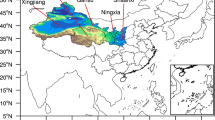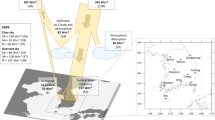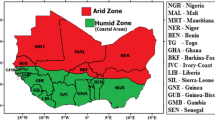Abstract
This study analyzed the surface radiation characteristics and evaluated downward cloud radiative forcing (CRF) in southern **njiang during summer 2019. Surface radiation fluxes show prominent day-to-day and diurnal variations, with the maximums of 915.6, 921.2, and 121.9 Wm−2, respectively, for total, direct, and diffuse shortwave radiations under cloudless conditions. Cloud layer or dust layer could significantly impede the incident solar irradiance and moderately reduce the emission of longwave radiation to space, and hence bring a strong downward negative radiative impact. A rigorous four-step screening algorithm was applied to effectively identify the clear-sky periods based on 1-min total and diffuse shortwave irradiances. The clear-sky shortwave (SW) radiation is empirically fitted using a power law equation and cosine of solar zenith angle, and the clear-sky longwave (LW) radiation is calculated via the average diurnal cycles of all datasets of detected 1-min LW radiation under cloudless conditions. The 24-h daily mean CRFs of SW are largely negative (− 204.1 to − 3.3 Wm−2), and corresponding LW are moderately positive (− 1.5 to + 70.4 Wm−2), which coincide with the overcast conditions or large cloud cover amounts. The overall averages of SW and LW CRFs and net cloud effect are − 69.7 ± 62.3, + 29.5 ± 22.2, and − 40.1 ± 42.1 Wm−2, respectively, implying that clouds have a net cooling effect on the regional climate. Our results are consistent with the summer mean values in northern China, but less than those in southern China, and greater than those of the global mean values. Such negative cloud radiative forcing would partly counteract the global warming induced by greenhouse gases and modulate the Earth’s radiation budget balance.












Similar content being viewed by others
Data availability
All the datasets used and analyzed in the current study are available from the corresponding author on reasonable request (Email: bijr@lzu.edu.cn).
References
Aili I (2012) The analysis of climate change and dust aerosol in Niya, the south margin of Taklimakan desert. Master’ thesis pp 25–30. (In Chinese)
Bi J, Huang J, Fu Q, Ge J, Shi J, Zhou T, Zhang W (2013) Field measurement of clear-sky solar irradiance in Badain Jaran desert of Northwestern China. J Quant Spectrosc Radiat Transf 122:194–207
Bi J, Huang J, Hu Z, Holben BN, Guo Z (2014) Investigating the aerosol optical and radiative characteristics of heavy haze episodes in Bei**g during January of 2013. J Geophys Res 119(16):9884–9900
Boucher O, Randall D, Artaxo P, et al (2013) Clouds and aerosols. In: Stocker TF, Qin D, Plattner G-K et al (eds) Climate change 2013: the physical science basis. contribution of working group I to the fifth assessment report of the intergovernmental panel on climate change. Cambridge University Press, pp 571–658
Cess RD, Zhang M, Minnis P, Corsetti L, Dutton EG, Forgan BW, Garber DP, Gates WL, Hack JJ, Harrison EF, **g X, Kiehi JT, Long CN, Morcrette J-J, Potter GL, Ramanathan V, Subasilar B, Whitlock CH, Young DF, Zhou Y (1995) Absorption of solar radiation by clouds: observations versus models. Science 267(5197):496–499
Che H, Shi G, Zhang X, Arimoto R, Zhao J, Xu L, Wang B (2005) Analysis of 40 years of solar radiation data from China, 1961–2000. Geophys Res Lett 32(6):L06803. https://doi.org/10.1029/2004GL022322
Chen Y, Peng K, Shi Y, Cui C, Lin X, Pan H (2009) Comparison of cloud water resources over Tianshan mountains and Taklimakan desert. Arid Land Geogr 32(6):886–891 (In Chinese)
Durr B, Philipona R (2004) Automatic cloud amount detection by surface longwave downward radiation measurements. J Geophys Res 109:D05021. https://doi.org/10.1029/2003JD004182
Dutton EG, Nelson DW, Stone RS, Longenecker D, Carbaugh G, Harris JM, Wendell J (2006) Decadal variations in surface solar irradiance as observed in a globally remote network. J Geophys Res 111(D19):D19101. https://doi.org/10.1029/2005JD006901
He Q, Miao Q, Li S, Shi L, Ali M (2008) Global radiation characteristics and influencing factors of Taklimakan desert hinterland. J Desert Res 28(5):896–902 (In Chinese)
Huang J, Minnis P, Lin B, Wang T, Yi Y, Hu Y, Sun-Mack S, Ayers K (2006) Possible influences of Asian dust aerosols on cloud properties and radiative forcing observed from MODIS and CERES. Geophys Res Lett 33(6):L06824. https://doi.org/10.1029/2005GL024724
** L, Li Z, He Q, Liu Y, Ali M, Liu X, Huo W, **n Y, Zhang J, Zhou C (2018) Observed key surface parameters for characterizing land-atmospheric interaction in the Northern marginal zone of the Taklimakan desert. China Atmos 9:458. https://doi.org/10.3390/atmos9120458
Khatri P, Takamura T (2009) An algorithm to screen cloud-affect data for sky radiometer data analysis. J Meteor Soc Jpn 87(1):189–204
Li J, Huang J, Wang T, Yi Y (2009) Analysis of vertical distribution of cloud in East Asia by space-based LiDAR data. Chin J Atmos Sci 33(4):698–707 (In Chinese)
Li S, Hu L, He Q, Xu Z, Wu X (2012) Surface radiation budget in hinterland of the Taklimakan desert. J Desert Res 32(4):1035–1044 (In Chinese)
Li J, Wang T, Habib A (2017) Observational characteristics of cloud radiative effects over three arid regions in the Northern Hemisphere. J Meteor Res 31(4):654–664
Li J, Jian B, Huang J, Hu Y, Zhao C, Kawamoto K, Liao S, Wu M (2018) Long-term variation of cloud droplet number concentrations from space-based Lidar. Remote Sens Environ 213:144–161
Li S, Hou X, Cui Y, Liang F, Xu Z (2019) Research on cloud characteristics based on FY-2F satellite data in **njiang region. Plateau Meteorol 38(3):617–624 (In Chinese)
Liang F, **a X (2005) Long-term trends in solar radiation and the associated climatic factors over China for 1961–2000. Ann Geophys 23:2425–2432
Liou KN (1992) Radiation and cloud processes in the atmosphere [M]. Oxford University Press, New York, pp 172–248
Liu YQ, He Q, Zhang HS, Ali M (2012) Improving the CoLM in Taklimakan desert hinterland with accurate key parameters and appropriate parameterization scheme. Adv Atmos Sci 29(2):381–390
Long CN, Ackerman TP (2000) Identification of clear skies from broadband pyranometer measurements and calculation of downwelling shortwave cloud effects. J Geophys Res 105(D12):15609–15626
Long CN, Turner DD (2008) A method for continuous estimation of clear-sky downwelling longwave radiative flux developed using ARM surface measurements. J Geophys Res 113:D18206. https://doi.org/10.1029/2008JD009936
Lowe Paul R (1977) An approximating polynomial for the computation of saturation vapor pressure. J Appl Meteorol 16(1):100–103
Mace G, Benson S, Sonntag K, Kato S, Min Q, Minnis P, Twohy CH, Poellot M, Dong X, Long C, Zhang Q, Doelling DR (2006) Cloud radiative forcing at the atmospheric radiation measurement program climate research facility. 1: technique, validation, and comparison to satellite-derived diagnostic quantities. J Geophys Res 111(D11):D11S90. https://doi.org/10.1029/2005JD005921
McFarlane SA, Long CN, Flaherty J (2013) A climatology of surface cloud radiative effect at the ARM tropical western Pacific sites. J Appl Meteorol Clim 52:1006–1013
Pinker RT, Zhang B, Dutton EG (2005) Do satellites detect trends in surface solar radiation? Science 308:850–854
Ramanathan V, Cess R, Harrison E, Minnis P, Barkstrom BR, Ahmad E, Hartmann D (1989) Cloud-radiative forcing and climate: results from the earth radiation budget experiment. Science 243:57–63
Shi G, Hayasaka T, Ohmura A, Chen Z, Wang B, Zhao J, Che H, Xu L (2008) Data quality assessment and the long-term trend of ground solar radiation in China. J Appl Meteorol Clim 47(4):1006–1016
Su J, Huang J, Fu Q, Minnis P, Ge J, Bi J (2008) Estimation of Asian dust aerosol effect on cloud radiation forcing using Fu-Liou radiative model and CERES measurements. Atmos Chem Phys 8:2763–2771
Tang JP, Wang PC, **a X (2011) Modification of cloud screening method using ground-based broadband shortwave irradiance measurements. Clim Environ Res 16(5):609–619 (In Chinese)
Waliser DE, Collins WD, Anderson SP (1996) An estimate of the surface shortwave cloud forcing over the western Pacific during TOGA COARE. Geophys Res Lett 23:519–522
Wang K, Dickinson RE (2013) Global atmospheric downward longwave radiation at the surface from ground-based observations, satellite retrievals, and reanalyses. Rev Geophys 51:150–185
Wang M, Wei W, He Q, Yang Y, Fan L, Zhang J (2016) Summer atmospheric boundary layer structure in the hinterland of Taklimakan desert. China J Arid Land 8(6):846–860
Wang M, Hu M, Huo W, Xu H, Li J, Li X (2017) Detecting sand-dust storms using a wind-profiling radar. J Arid Land 9(5):753–762
Wild M (2009) Global dimming and brightening: a review. J Geophys Res 114:D00D16. https://doi.org/10.1029/2008JD011470
**ang H, Zhang F, Jiang J, Peng J, Zhang X, Zhang C (2014) Analysis of global cloud amount over the past 30 years based on CFSR data. Meteorol Mon 40(5):555–561 (In Chinese)
Yang F, He Q, Huang J, Ali M, Yang X, Huo W, Zhou C, Liu X, Wei W, Cui C, Wang M, Li H, Yang L, Zhang H, Liu Y, Zheng X, Pan H, ** L, Zou H, Zhou L, Liu Y, Zhang J, Meng L, Wang Y, Qin X, Yao Y, Liu H, Xue F, Zheng W (2021) Desert environment and climate observations network over the Taklimakan desert. B AM Meteorol Soc. https://doi.org/10.1175/BAMS-D-20-0236
Zhang H, Peng J, **g X, Li J (2013) The features of cloud overlap** in eastern Asia and their effect on cloud radiative forcing. Sci China Earth Sci 56(5):737–747
Zhang H, **e B, Liu Y, Wang F, Wang Z, Zhang J, Li J, Letu H, Shang H, Chen Y, Xuan Y (2017) Study on the influence of clouds on the Earth radiation budget and precipitation changes in East Asia region. China Basic Sci 5:18–22 (In Chinese)
Acknowledgements
This study was supported by the National Science Foundation of China (42075126), Project of Field Scientific Observation and Research Station of Gansu Province (18JR2RA013), and the Fundamental Research Funds for the Central Universities (lzujbky-2021-kb02,lzujbky-2021-sp04), and China 111 Project (No. B 13045). The authors would like to express special thanks to all staff of Minfeng Country Bureau of Meteorology for supporting the field experiment. We also appreciate all anonymous reviewers and editors for their constructive and insightful comments.
Author information
Authors and Affiliations
Corresponding author
Additional information
Responsible Editor: **nxin **e.
Publisher's Note
Springer Nature remains neutral with regard to jurisdictional claims in published maps and institutional affiliations.
Rights and permissions
About this article
Cite this article
Bi, J., Zuo, D., Yang, F. et al. Surface radiation characteristics and downward cloud radiative forcing in southern **njiang during summer 2019. Meteorol Atmos Phys 134, 11 (2022). https://doi.org/10.1007/s00703-021-00847-5
Received:
Accepted:
Published:
DOI: https://doi.org/10.1007/s00703-021-00847-5




